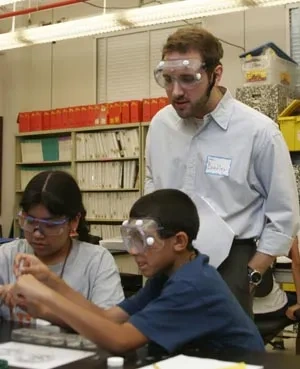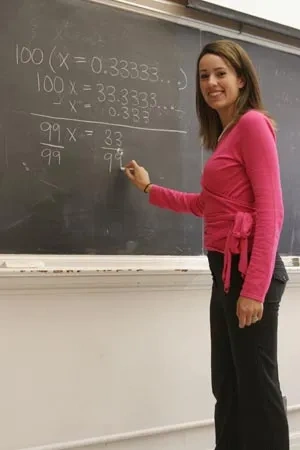Rooting for STEM
In 14 years, UTeach has created a unique educational model for preparing science, technology, engineering, and math teachers, and the nation is following its lead.
[caption id="attachment_2451" align="alignright" width="300"]

Photo by Mark Tway[/caption]
In the fall of 1997, Dean Mary Ann Rankin and other College of Natural Sciences leaders persuaded 28 of the college’s brightest students to take an experimental course that would put them at the front of elementary school classrooms and get them thinking about teaching. They couldn’t have known that it would be the first step toward reinventing math and science teacher education across the country.
But with collaboration from the College of Education it became just that.
It’s hard to get politicians across party lines to agree, but one thing none can argue with is the nation’s need for quality education in the areas of science, technology, engineering, and math (STEM)—and that far too many K-12 students aren’t getting it today.
Presidents George W. Bush and Barack Obama both drew attention to the need for better STEM programs, and both singled out UTeach as a model solution.
Today, UTeach has graduated more than 600 students, all of whom are proficient in their subject matter and 80 percent of whom are still teaching five years later. Nationally, more than 30 percent of new teachers leave the profession in the same time.
This fall, hundreds more math and science graduates from U.S. universities that have replicated the program will enter classrooms as experts in the subject matter and with the skills to teach it.
The Root of the Problem
Dean Rankin remembers overhearing two students talking in the Union a few years after the program launched. “What’s your major?” one asked. “UTeach,” the other replied enthusiastically. “I’ve heard that’s a great program,” the first said in return. Rankin beams at the memory.
Teaching certification for science majors used to be looked at as an insurance policy if medical school or industry jobs didn’t come through, Rankin says. Few students were seeking it out, and it certainly was not something faculty recommended to top students.
That attitude has taken a 180 at the University, thanks in part to the enthusiasm of students, the stature of respected faculty members and administrators involved with UTeach, and the expertise lent by master high school teachers.
UT faculty members now understand that to get the most talented math and science students to UT, there must be talented math and science educators in the school systems. Like the symbiotic relationships of clownfish and sea anemone protecting one another, or birds eating ticks off of cattle, it’s mutually beneficial.
The Seeds of Success
The summer before the first introductory class kicked off, the University convened a group of outstanding high school math and science teachers and asked them to design the teacher-preparation program they wished they’d had.
Their results became the bones of UTeach. They suggested that students be exposed to teaching in their first semester and that elementary classrooms would be the most welcoming. Rankin was so enthusiastic she put the first class in place that fall.
In what is called Step 1, the students learn about the five E’s of teaching—engagement, exploration, explanation, elaboration, and evaluation—and, with a partner, put them in practice with three lessons delivered to young students.
“We taught a third grade class. We botched it, but they gave us hugs after,” says junior math UTeach major Mark Townsend. “It’s why we start with elementary. Even if you fail, it’s still successful. Elementary kids are nicer than high schoolers.”

In the next class, Step 2, students repeat the process with middle schoolers. Afterward, 60 to 70 percent continue through the UTeach program. The early classroom experience improves the retention rate of those who do decide to teach, and it’s a risk-free trial for those who don’t — the college reimburses all students for the tuition of the intro courses.
Along with the requirements for typical natural sciences majors, the future teachers take a handful of other UTeach courses. Designed and administered in partnership with the College of Education, the classes go beyond generic teaching methods, focusing on the best ways to teach math and science to middle and high school students.
“UTeach emphasizes teaching students how to use inquiry and project-based instruction,” Rankin says. “Some think teaching that way is only for the cream of the crop, but it’s the best method for at-risk students. It gives them confidence. It’s the real hallmark of UTeach.”
In the final semester of the four-year program, students spend half-days student teaching.
“If you want to be a great math and science teacher,” program co-director Michael Marder says, “you need to, first of all, know your material very well. Then you need to understand very well why students have difficulty with it and have specific strategies to help different kinds of students learn. So the classes are built around those premises.”
The preparation helps most graduates avoid the typical first-year teaching shock. And master teachers from schools in and around Austin provide a support system in the first year with regular check-ins.
Pollination
Other schools took notice of UTeach early on. Texas A&M paid a visit, as did faculty from the University of California and California State University systems and Bruce Alberts, then-president of the National Academy of Sciences.
Then in 2006, as the program prepared to celebrate its 10th anniversary, the Texas High School Project and the Texas Education Agency offered funding to replicate it at several universities in Texas. The National Math and Science Initiative soon jumped on board, with the backing of ExxonMobil and the Michael and Susan Dell Foundation, to take things national.
Once again breaking new ground in higher education, Rankin recruited alumna Tracy LaQuey Parker, BA ’86, Life Member, to lead the UTeach Institute, which essentially franchises the program. With the help of corporate and foundation funds, state and federal grants, and even individual giving, the institute is guiding 21 universities through a five-year implementation process.
“Institutional change is difficult. It takes time to change,” Parker says. “The UTeach program requires commitment from the leadership at a university, the staff, the faculty, the colleges. So it’s this multi-dimensional, multi-layered institutional change that’s going on.”
The institute provides course plans, equipment lists, hiring recommendations, tips for attracting students—everything that took The University of Texas years to troubleshoot and tweak.
“This is a model that we think is really solid and really good and has demonstrated great results,” Parker says. “We make it very clear in selection our expectations are fidelity to the model. That is not how a normal grant process works in a university. Normally, a group will get grant funding to go discover something new or do innovative new research or something like that. This is very different.”
By 2017 the program expects to be producing more than 1,000 math and science teachers annually. That number is expected to grow exponentially in the coming decades. The institute is already preparing for a third cohort that will include universities in Massachusetts and Georgia. Both states designated Race to the Top funds for UTeach replication.
In September, Obama announced a goal of educating 100,000 STEM teachers in the next decade. A few months later, he signed into law a bill to reauthorize the America COMPETES Act. A main provision of the act calls for federal grants to replicate and implement university STEM-teacher-training programs. While UTeach isn’t specifically named and the funding isn’t certain to be distributed through the institute, the program requirements are identical.
“Our nation’s success depends on strengthening America’s role as the world’s engine of discovery and innovation,” Obama has said. “That leadership tomorrow depends on how we educate our students today—especially in science, technology, engineering, and math.”





